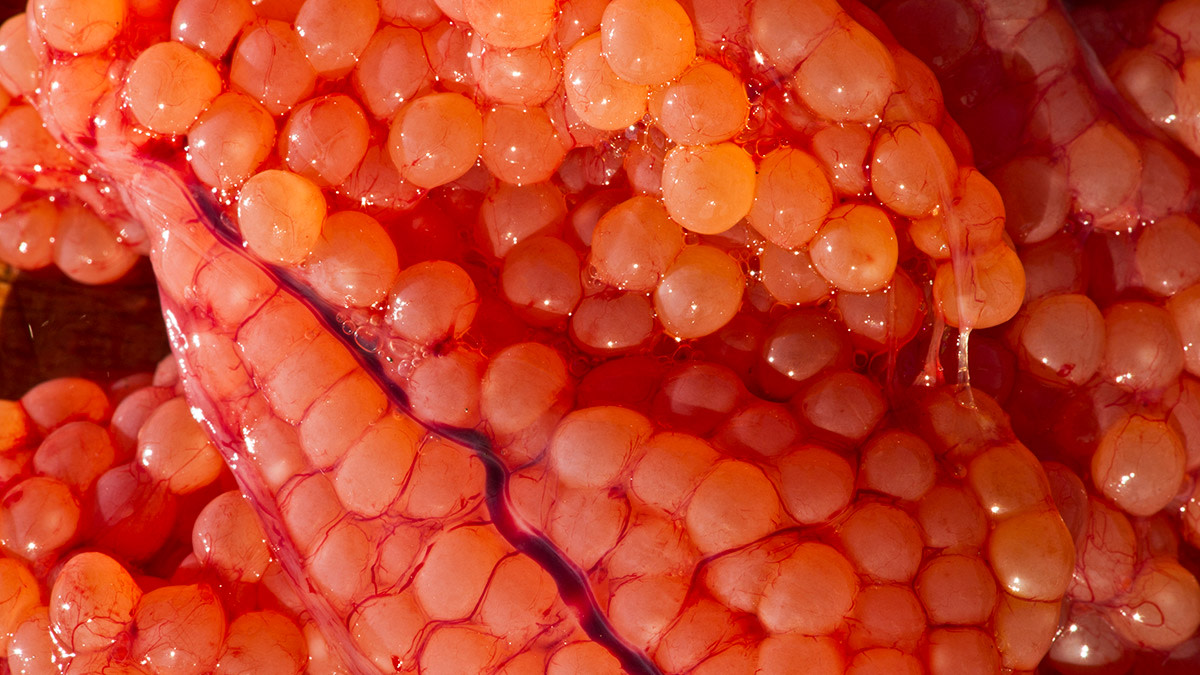
Casual anglers might struggle to gather sufficient organs for all the different preparations I’m covering in this series. My intention, really, is to show you that these organs are edible and encourage you to sample a few. If you find that you really like particular bits, you can do what I’ve done for a lot of this research, and source organs from a local fish monger. Really, though, I just hope that less of the fish you choose to harvest winds up getting tossed out.
In the last edition of Nostril to Caudal, “Can You Really Eat Fish Organs?,” we talked about ways to eat about half of the organs within a fish’s ribcage cavity, including the heart, liver, intestines, stomach, and air bladder. I figured there’s probably too many edible organs in there to throw at you all at once (not literally). So, we saved a few for a second article, especially those toward the top and back of the cavity: eggs, milt, spinal cords, kidneys, and spleens.
The great thing about this selection of offal is that they are easily prepared as standalone snacks. Gitga’at First Nation anthropologist Spencer Greening grew up eating fish this way. His indigenous community on the west coast of British Columbia relishes the organs from eulachon, halibut, salmon, and other fishes. His elders have mastered preparing fish by smoking or indirect heat grilling, often with the organs alongside the meat. So, next time you’re waiting for your fillets to finish on the barbecue, try throwing some of these bits on there as well. I think you’ll be pleasantly surprised.
Gonads (Eggs and Milt)
I remember having this discussion with Greening when we podcasted last year. I knew eating fish roe was popular, from salmon skeins and sturgeon caviar to flying fish tobiko, but had yet to hear of anyone eating milt. When the Gitga’at take the sperm sacs from fresh salmon, these gonads come out in a thick, solid block. When he told me that he and his family mash them up to put in soup, right away I guessed it was a fertility superstition. He assured me it was actually just delicious.
Turns out he’s right! Milt and roe can be prepared with a number of the same easy, tasty recipes. Many folks like to just salt them and eat them. Creamy soups and pan frying are a great way for adventurous palates to give it a try, but there are also many subtle ways to prepare fish gonads. Some cultures ferment or preserve them, but they’re also perfectly suited to salting, drying, smoking, and grating atop meals as seasoning. They’re also fantastic to partially dry out, grind into powder, and turn into sauces.
Kidneys
A fish’s kidney is that line of what appears to be congealed blood resting along the underside of the backbone. Back when I guided for salmon on the Fraser River, gutting fish was a part of my everyday tasks. I used an old spoon to scrape out and discard what I thought was blood, but I now realize were kidneys.
The kidneys are the perfect organs to use in blood sausage and black pudding. Both variations typically use pork blood, so fish blood can be beneficial for certain religions and health conscious consumers. I’ve had blood pudding in several countries, each with their own style and recipe. Fish blood doesn’t taste like fish, but it sure will soak up all the other yummy flavours you mix into it.
Spinal Cords
Every fall, salmon spines and vertebrae litter the riverbanks of the Pacific Northwest. They’re picked clean by birds and other organisms before turning brittle in the sun and eventually disintegrating into the earth. When fresh, however, the spinal cord is all juices, marrow, and vitamins. It’s a flavourful jelly that remains intact when spiced and grilled.
I’ve always included spinal cords in my fish stocks and brines and have left it intact when canning fish. They soften during the canning process and don’t need to be picked out. We grew up mashing mom’s canned salmon with a dollop of Miracle Whip.
Spencer grew up eating it a little differently. “Halibut spinal cords hold a bunch of juice—we love to cook it a special way where you fry it, then snap the vertebrae and suck out the juices,” he told me. “It’s my absolute favourite meal at our seaweed camp.”
Spleen
Depending on the species, the spleen is a small, dark organ that sits near the middle of the fish. It is cooked similarly to the heart—as fresh as possible and over indirect heat. They’re excellent when threaded onto a skewer and grilled over charcoal. It’s best to avoid direct heat on any oxygenated, lean organs because they can get tough and chewy. Like milt and eggs, the spleen can also be salted, smoked, and grated as a smoky seasoning on vegetables, meats, and sauces—Josh Niland’s favourite move.
Simple is often best when it comes to trying out new flavours. Almost everything tastes better with a little salt, garlic, and onion. So, stoke your fire, burn down those coals, grease that cast iron, and do some experimenting with fish organs. You just might surprise yourself with how much you enjoy the easy cooking, pleasing flavors, and the satisfaction of using the whole fish.




Conversation